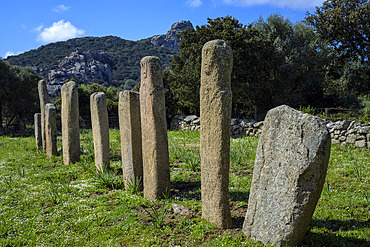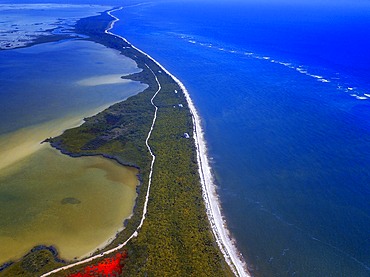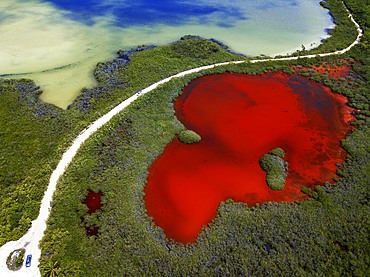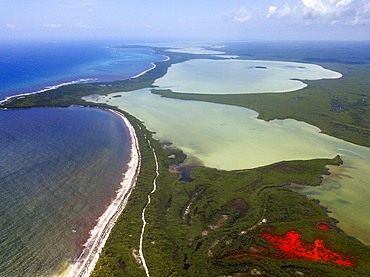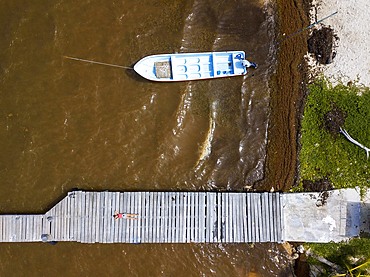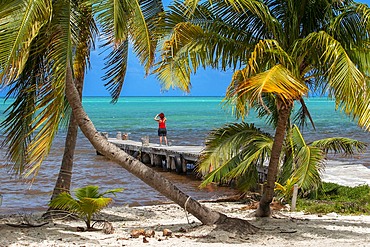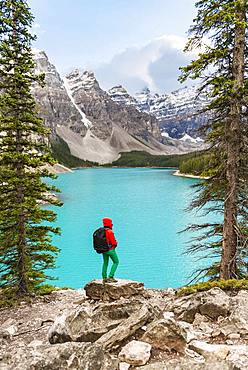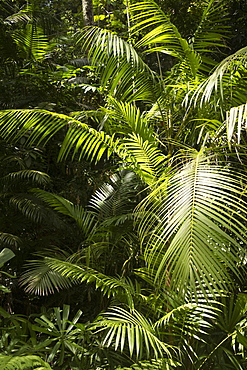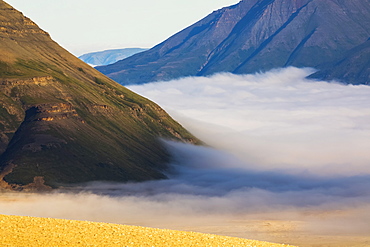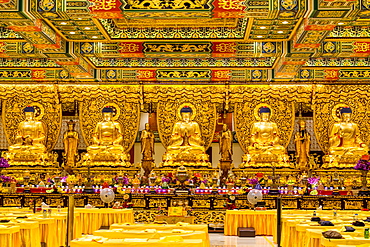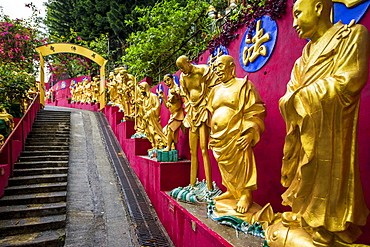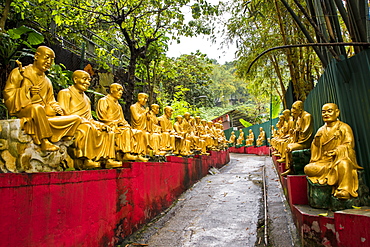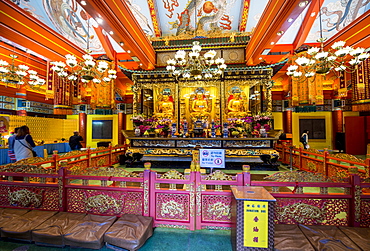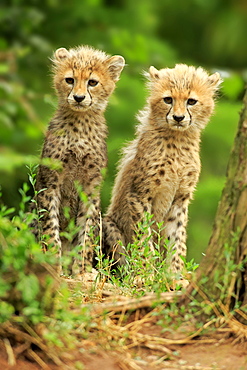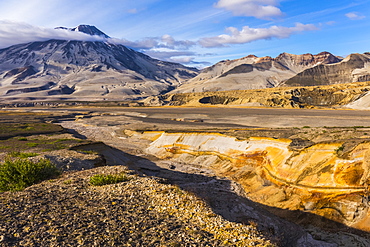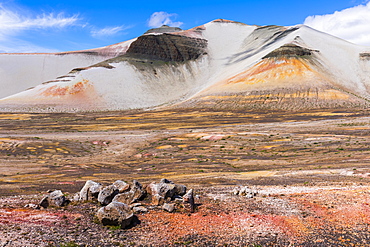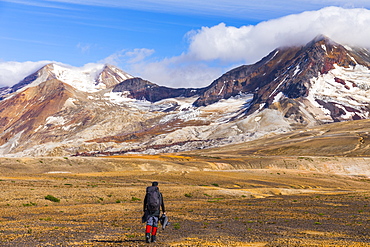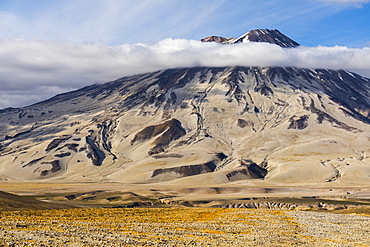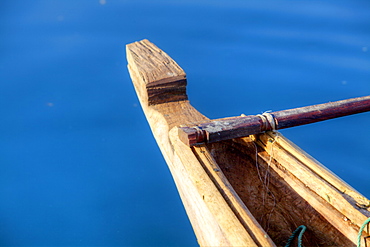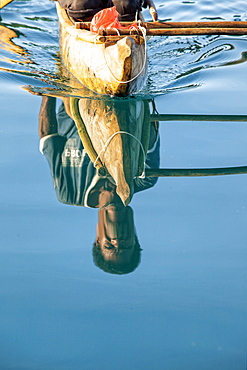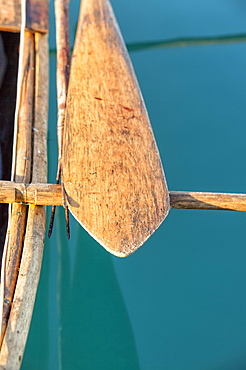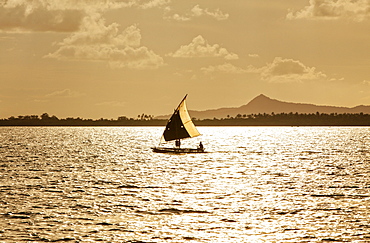Recent searches
Loading...
860-292046 - Alignment of statue-menhirs at I Stantari. Cauria megalithic site, located in the commune of Sartene in southern Corsica. The site was occupied from the Early Neolithic to the end of the Bronze Age. Some ten statue-menhirs can be seen in two alignments, on which reliefs (swords, belts, loincloths, faces, arms and hands) can be distinguished.
832-401295 - Elegant girl sits at the concert grand and plays the piano
832-401296 - Elegant girl sits at the concert grand and plays the piano
1350-6627 - Aerial view of Punta Allen Sian Ka'an Reserve, Yucatan Peninsula, Mexico. Red lagoon near Boca Paila Bridge.
In the language of the Mayan peoples who once inhabited this region, Sian Ka'an means Origin of the Sky. Located on the east coast of the Yucatán peninsula, this biosphere reserve contains tropical forests, mangroves and marshes, as well as a large marine section intersected by a barrier reef. It provides a habitat for a remarkably rich flora and a fauna comprising more than 300 species of birds, as well as a large number of the region's characteristic terrestrial vertebrates, which cohabit in the diverse environment formed by its complex hydrological system.
Along its roughly 120 kilometres of coastline, the property covers over 400,000 hectares of land ranging from sea level to only ten m.a.s.l. The property boasts diverse tropical forests, palm savannah, one of the most pristine wetlands in the region, lagoons, extensive mangrove stands, as well as sandy beaches and dunes. The 120,000 hectares of marine area protect a valuable part of the Mesoamerican Barrier Reef and seagrass beds in the shallow bays. The lush green of the forests and the many shades of blue of the lagoons and the Caribbean Sea under a wide sky offer fascinating visual impressions.
1350-6623 - Aerial view of Punta Allen Sian Ka'an Reserve, Yucatan Peninsula, Mexico. Red lagoon near Boca Paila Bridge.
In the language of the Mayan peoples who once inhabited this region, Sian Ka'an means Origin of the Sky. Located on the east coast of the Yucatán peninsula, this biosphere reserve contains tropical forests, mangroves and marshes, as well as a large marine section intersected by a barrier reef. It provides a habitat for a remarkably rich flora and a fauna comprising more than 300 species of birds, as well as a large number of the region's characteristic terrestrial vertebrates, which cohabit in the diverse environment formed by its complex hydrological system.
Along its roughly 120 kilometres of coastline, the property covers over 400,000 hectares of land ranging from sea level to only ten m.a.s.l. The property boasts diverse tropical forests, palm savannah, one of the most pristine wetlands in the region, lagoons, extensive mangrove stands, as well as sandy beaches and dunes. The 120,000 hectares of marine area protect a valuable part of the Mesoamerican Barrier Reef and seagrass beds in the shallow bays. The lush green of the forests and the many shades of blue of the lagoons and the Caribbean Sea under a wide sky offer fascinating visual impressions.
1350-6625 - Aerial view of Punta Allen Sian Ka'an Reserve, Yucatan Peninsula, Mexico. Red lagoon near Boca Paila Bridge.
In the language of the Mayan peoples who once inhabited this region, Sian Ka'an means Origin of the Sky. Located on the east coast of the Yucatán peninsula, this biosphere reserve contains tropical forests, mangroves and marshes, as well as a large marine section intersected by a barrier reef. It provides a habitat for a remarkably rich flora and a fauna comprising more than 300 species of birds, as well as a large number of the region's characteristic terrestrial vertebrates, which cohabit in the diverse environment formed by its complex hydrological system.
Along its roughly 120 kilometres of coastline, the property covers over 400,000 hectares of land ranging from sea level to only ten m.a.s.l. The property boasts diverse tropical forests, palm savannah, one of the most pristine wetlands in the region, lagoons, extensive mangrove stands, as well as sandy beaches and dunes. The 120,000 hectares of marine area protect a valuable part of the Mesoamerican Barrier Reef and seagrass beds in the shallow bays. The lush green of the forests and the many shades of blue of the lagoons and the Caribbean Sea under a wide sky offer fascinating visual impressions.
1350-6620 - Aerial view of Punta Allen Sian Ka'an Reserve, Yucatan Peninsula, Mexico. Red lagoon near Boca Paila Bridge.
In the language of the Mayan peoples who once inhabited this region, Sian Ka'an means Origin of the Sky. Located on the east coast of the Yucatán peninsula, this biosphere reserve contains tropical forests, mangroves and marshes, as well as a large marine section intersected by a barrier reef. It provides a habitat for a remarkably rich flora and a fauna comprising more than 300 species of birds, as well as a large number of the region's characteristic terrestrial vertebrates, which cohabit in the diverse environment formed by its complex hydrological system.
Along its roughly 120 kilometres of coastline, the property covers over 400,000 hectares of land ranging from sea level to only ten m.a.s.l. The property boasts diverse tropical forests, palm savannah, one of the most pristine wetlands in the region, lagoons, extensive mangrove stands, as well as sandy beaches and dunes. The 120,000 hectares of marine area protect a valuable part of the Mesoamerican Barrier Reef and seagrass beds in the shallow bays. The lush green of the forests and the many shades of blue of the lagoons and the Caribbean Sea under a wide sky offer fascinating visual impressions.
1350-6616 - Aerial view of Punta Allen Sian Ka'an Reserve, Yucatan Peninsula, Mexico.
In the language of the Mayan peoples who once inhabited this region, Sian Ka'an means Origin of the Sky. Located on the east coast of the Yucatán peninsula, this biosphere reserve contains tropical forests, mangroves and marshes, as well as a large marine section intersected by a barrier reef. It provides a habitat for a remarkably rich flora and a fauna comprising more than 300 species of birds, as well as a large number of the region's characteristic terrestrial vertebrates, which cohabit in the diverse environment formed by its complex hydrological system.
Along its roughly 120 kilometres of coastline, the property covers over 400,000 hectares of land ranging from sea level to only ten m.a.s.l. The property boasts diverse tropical forests, palm savannah, one of the most pristine wetlands in the region, lagoons, extensive mangrove stands, as well as sandy beaches and dunes. The 120,000 hectares of marine area protect a valuable part of the Mesoamerican Barrier Reef and seagrass beds in the shallow bays. The lush green of the forests and the many shades of blue of the lagoons and the Caribbean Sea under a wide sky offer fascinating visual impressions.
1350-6615 - Palms and old pier in Punta Allen Sian Ka'an Reserve, Yucatan Peninsula, Mexico.
In the language of the Mayan peoples who once inhabited this region, Sian Ka'an means Origin of the Sky. Located on the east coast of the Yucatán peninsula, this biosphere reserve contains tropical forests, mangroves and marshes, as well as a large marine section intersected by a barrier reef. It provides a habitat for a remarkably rich flora and a fauna comprising more than 300 species of birds, as well as a large number of the region's characteristic terrestrial vertebrates, which cohabit in the diverse environment formed by its complex hydrological system.
Along its roughly 120 kilometres of coastline, the property covers over 400,000 hectares of land ranging from sea level to only ten m.a.s.l. The property boasts diverse tropical forests, palm savannah, one of the most pristine wetlands in the region, lagoons, extensive mangrove stands, as well as sandy beaches and dunes. The 120,000 hectares of marine area protect a valuable part of the Mesoamerican Barrier Reef and seagrass beds in the shallow bays. The lush green of the forests and the many shades of blue of the lagoons and the Caribbean Sea under a wide sky offer fascinating visual impressions.
832-397755 - Clouds hanging between mountain peaks, mountain range behind turquoise glacial lake, sunrise, Moraine Lake, Valley of the Ten Peaks, Rocky Mountains, Banff National Park, Alberta Province, Canada, North America
832-397753 - Cloudy mountain peaks, reflection in turquoise glacial lake, Moraine Lake, Valley of the Ten Peaks, Rocky Mountains, Banff National Park, Alberta Province, Canada, North America
832-397754 - Mountain range behind turquoise glacial lake, Moraine Lake, Valley of the Ten Peaks, Rocky Mountains, Banff National Park, Alberta Province, Canada, North America
832-397752 - Cloudy mountain peaks, reflection in turquoise glacial lake, Moraine Lake, Valley of the Ten Peaks, Rocky Mountains, Banff National Park, Alberta Province, Canada, North America
832-393869 - Infant, girl, 10 days, Stuttgart, Baden-Wuerttemberg, Germany, Europe
832-393870 - Baby feet, infant, girl, 10 days, Stuttgart, Baden-Wuerttemberg, Germany, Europe
1116-51170 - A ten month old bull moose (Alces americanus) kneels in the snow and eats snow, Gaspesie National Park; Quebec, Canada
1350-2688 - Verges, a small town in the Northeast of Catalonia (Spain), during Easter celebrates the Procession of Verges with skeletons dancing on the sound of a drum, Roman soldiers, known as the 'Manages', and a representation of the life and crucifixion of Jesus Christ. The Procession features the Dance of Death, a tradition from the Middle Age associated with epidemics and plagues and the only one remaining in Spain Ten skeletons dance to the beat of a drum to remember that no one is exempt of death. The backdrop of the medieval walls and towers of Verges is key to this macabre staging.
1350-2693 - Verges, a small town in the Northeast of Catalonia (Spain), during Easter celebrates the Procession of Verges with skeletons dancing on the sound of a drum, Roman soldiers, known as the 'Manages', and a representation of the life and crucifixion of Jesus Christ. The Procession features the Dance of Death, a tradition from the Middle Age associated with epidemics and plagues and the only one remaining in Spain Ten skeletons dance to the beat of a drum to remember that no one is exempt of death. The backdrop of the medieval walls and towers of Verges is key to this macabre staging.
1350-2692 - Verges, a small town in the Northeast of Catalonia (Spain), during Easter celebrates the Procession of Verges with skeletons dancing on the sound of a drum, Roman soldiers, known as the 'Manages', and a representation of the life and crucifixion of Jesus Christ. The Procession features the Dance of Death, a tradition from the Middle Age associated with epidemics and plagues and the only one remaining in Spain Ten skeletons dance to the beat of a drum to remember that no one is exempt of death. The backdrop of the medieval walls and towers of Verges is key to this macabre staging.
1350-2695 - Verges, a small town in the Northeast of Catalonia (Spain), during Easter celebrates the Procession of Verges with skeletons dancing on the sound of a drum, Roman soldiers, known as the 'Manages', and a representation of the life and crucifixion of Jesus Christ. The Procession features the Dance of Death, a tradition from the Middle Age associated with epidemics and plagues and the only one remaining in Spain Ten skeletons dance to the beat of a drum to remember that no one is exempt of death. The backdrop of the medieval walls and towers of Verges is key to this macabre staging.
1350-2690 - Verges, a small town in the Northeast of Catalonia (Spain), during Easter celebrates the Procession of Verges with skeletons dancing on the sound of a drum, Roman soldiers, known as the 'Manages', and a representation of the life and crucifixion of Jesus Christ. The Procession features the Dance of Death, a tradition from the Middle Age associated with epidemics and plagues and the only one remaining in Spain Ten skeletons dance to the beat of a drum to remember that no one is exempt of death. The backdrop of the medieval walls and towers of Verges is key to this macabre staging.
1350-2691 - Verges, a small town in the Northeast of Catalonia (Spain), during Easter celebrates the Procession of Verges with skeletons dancing on the sound of a drum, Roman soldiers, known as the 'Manages', and a representation of the life and crucifixion of Jesus Christ. The Procession features the Dance of Death, a tradition from the Middle Age associated with epidemics and plagues and the only one remaining in Spain Ten skeletons dance to the beat of a drum to remember that no one is exempt of death. The backdrop of the medieval walls and towers of Verges is key to this macabre staging.
1350-2687 - Verges, a small town in the Northeast of Catalonia (Spain), during Easter celebrates the Procession of Verges with skeletons dancing on the sound of a drum, Roman soldiers, known as the 'Manages', and a representation of the life and crucifixion of Jesus Christ. The Procession features the Dance of Death, a tradition from the Middle Age associated with epidemics and plagues and the only one remaining in Spain Ten skeletons dance to the beat of a drum to remember that no one is exempt of death. The backdrop of the medieval walls and towers of Verges is key to this macabre staging.
1350-2689 - Verges, a small town in the Northeast of Catalonia (Spain), during Easter celebrates the Procession of Verges with skeletons dancing on the sound of a drum, Roman soldiers, known as the 'Manages', and a representation of the life and crucifixion of Jesus Christ. The Procession features the Dance of Death, a tradition from the Middle Age associated with epidemics and plagues and the only one remaining in Spain Ten skeletons dance to the beat of a drum to remember that no one is exempt of death. The backdrop of the medieval walls and towers of Verges is key to this macabre staging.
1350-2696 - Verges, a small town in the Northeast of Catalonia (Spain), during Easter celebrates the Procession of Verges with skeletons dancing on the sound of a drum, Roman soldiers, known as the 'Manages', and a representation of the life and crucifixion of Jesus Christ. The Procession features the Dance of Death, a tradition from the Middle Age associated with epidemics and plagues and the only one remaining in Spain Ten skeletons dance to the beat of a drum to remember that no one is exempt of death. The backdrop of the medieval walls and towers of Verges is key to this macabre staging.
1350-2697 - Verges, a small town in the Northeast of Catalonia (Spain), during Easter celebrates the Procession of Verges with skeletons dancing on the sound of a drum, Roman soldiers, known as the 'Manages', and a representation of the life and crucifixion of Jesus Christ. The Procession features the Dance of Death, a tradition from the Middle Age associated with epidemics and plagues and the only one remaining in Spain Ten skeletons dance to the beat of a drum to remember that no one is exempt of death. The backdrop of the medieval walls and towers of Verges is key to this macabre staging.
1350-2694 - Verges, a small town in the Northeast of Catalonia (Spain), during Easter celebrates the Procession of Verges with skeletons dancing on the sound of a drum, Roman soldiers, known as the 'Manages', and a representation of the life and crucifixion of Jesus Christ. The Procession features the Dance of Death, a tradition from the Middle Age associated with epidemics and plagues and the only one remaining in Spain Ten skeletons dance to the beat of a drum to remember that no one is exempt of death. The backdrop of the medieval walls and towers of Verges is key to this macabre staging.
832-391440 - Stacks of ten thousand dollar piles of one hundred dollar bills
832-391441 - Stacks of ten thousand dollar piles of one hundred dollar bills
832-391443 - Stacks of ten thousand dollar piles of one hundred dollar bills
832-391372 - Stacks of ten thousand dollar piles of one hundred dollar bills
832-391445 - Stacks of ten thousand dollar piles of one hundred dollar bills
832-391439 - Stack of ten thousand dollar piles of one hundred dollar bills & dice on a black background
832-391438 - Stack of ten thousand dollar piles of one hundred dollar bills, red dice & poker chips on a black background
832-391437 - Stack of ten thousand dollar piles of one hundred dollar bills, red dice & poker chips on a black background
805-288 - Hindu musicians singing ragas and playing ten scale Indian harmonium keyboard, tabla, pipe and hand cymbals, West Bengal, India, Asia
832-390994 - Clouds hanging between mountain peaks, reflection in turquoise glacial lake, Moraine Lake, Valley of the Ten Peaks, Rocky Mountains, Banff National Park, Alberta Province, Canada, North America
832-390995 - Clouds hanging between mountain peaks, reflection in turquoise glacial lake, Moraine Lake, Valley of the Ten Peaks, Rocky Mountains, Banff National Park, Alberta Province, Canada, North America
1113-103541 - Ten Thousand Arm Buddha Performance,Aboard MV Victoria Queen, Victoria Cruises, Yangtze River, China
832-384212 - Young woman standing in front of a lake looking into mountain scenery, clouds hanging between mountain peaks, reflection in turquoise lake, Moraine Lake, Valley of the Ten Peaks, Rocky Mountains, Banff National Park, Province of Alberta, Canada, North America
832-384210 - Clouds hanging between the mountain peaks, reflection in turquoise glacial lake, Moraine Lake, Valley of the Ten Peaks, Rocky Mountains, Banff National Park, Alberta Province, Canada, North America
832-384289 - Hiker standing on the shore of a lake, mountain peaks at the back, turquoise glacial lake, Moraine Lake, Valley of the Ten Peaks, Rocky Mountains, Banff National Park, Alberta Province, Canada, North America
832-384270 - White-tailed deer (Odocoileus virginianus), young animal, ten days, in the bushes, Pine County, Minnesota, USA, North America
832-384272 - White-tailed deer (Odocoileus virginianus), young animal, ten days, standing in flower meadow, Pine County, Minnesota, USA, North America
832-384271 - White-tailed deer (Odocoileus virginianus), young animal, ten days, in the bushes, Pine County, Minnesota, USA, North America
832-384273 - White-tailed deer (Odocoileus virginianus), young animal, ten days, standing in flower meadow, Pine County, Minnesota, USA, North America
832-384211 - Clouds hanging between the mountain peaks, reflection in turquoise glacial lake, Moraine Lake, Valley of the Ten Peaks, Rocky Mountains, Banff National Park, Alberta Province, Canada, North America
832-384274 - White-tailed deer (Odocoileus virginianus), young animal, ten days, standing in flower meadow, Pine County, Minnesota, USA, North America
785-2415 - Flora in the ten million year old rain forest in Langkawi, Malaysia, Southeast Asia, Asia
785-2409 - Flora in the ten million year old rain forest in Langkawi, Malaysia, Southeast Asia, Asia
1276-2254 - Inside of Wat Rong Suea Ten (Blue Temple) in Chiang Rai, Thailand, Southeast Asia, Asia
1276-2250 - Wat Rong Suea Ten (Blue Temple) in Chiang Rai, Thailand, Southeast Asia, Asia
1276-2248 - Wat Rong Suea Ten (Blue Temple) in Chiang Rai, Thailand, Southeast Asia, Asia
1116-46906 - A man and the Valley of Ten Thousand Smokes is framed by the doorway of one of the Baked Mountain Huts in Katmai National Park, Alaska, United States of America
1116-46905 - Morning fog blankets the lower Valley of Ten Thousand Smokes in Katmai National Park, Alaska, United States of America
1281-22 - Statue of Buddha inside Wat Rong Suea Ten (Blue Temple) in Chiang Rai, Thailand, Southeast Asia, Asia
1281-29 - Naga head at Wat Rong Suea Ten (Blue Temple) in Chiang Rai, Thailand, Southeast Asia, Asia
1281-20 - Green Yaksha statue at Wat Rong Suea Ten (Blue Temple) in Chiang Rai, Thailand, Southeast Asia, Asia
1281-24 - Statue of Buddha inside Wat Rong Suea Ten (Blue Temple) in Chiang Rai, Thailand, Southeast Asia, Asia
1281-23 - Exterior view of Wat Rong Suea Ten (Blue Temple) in Chiang Rai, Thailand, Southeast Asia, Asia
1281-25 - Statue of Buddha inside Wat Rong Suea Ten (Blue Temple) in Chiang Rai, Thailand, Southeast Asia, Asia
1281-28 - Front entrance of Wat Rong Suea Ten (Blue Temple) in Chiang Rai, Thailand, Southeast Asia, Asia
1281-31 - Fountain outside Wat Rong Suea Ten (Blue Temple) in Chiang Rai, Thailand, Southeast Asia, Asia
1281-27 - Naga head at Wat Rong Suea Ten (Blue Temple) in Chiang Rai, Thailand, Southeast Asia, Asia
1281-30 - Fountain and front entrance of Wat Rong Suea Ten (Blue Temple) in Chiang Rai, Thailand, Southeast Asia, Asia
1281-21 - Exterior view of Wat Rong Suea Ten (Blue Temple) in Chiang Rai, Thailand, Southeast Asia, Asia
1281-26 - Green Yaksha statue at Wat Rong Suea Ten (Blue Temple) in Chiang Rai, Thailand, Southeast Asia, Asia
1297-389 - The Ten Bells pub in Spitalfields, London, England, United Kingdom, Europe
832-381128 - Vairocana Buddha Prayer Wheel in the Ten Thousands Buddhas Pavilion, Buddha Tooth Relic Temple, Chinatown, Singapore, Asia
1276-519 - Moraine Lake and the Valley of the Ten Peaks, Banff National Park, UNESCO World Heritage Site, Canadian Rockies, Alberta, Canada, North America
1276-520 - Moraine Lake and the Valley of the Ten Peaks, Banff National Park, UNESCO World Heritage Site, Canadian Rockies, Alberta, Canada, North America
1298-11 - The classic English village of Welford-on-Avon with the thatched Ten Penny cottage alongside Boat Lane, Welford-on-Avon, Warwickshire, England, United Kingdom, Europe
796-2411 - Ten Thousand Buddhas Monastery, Sha Tin, Hong Kong, China, Asia
796-2423 - Grand Hall of Ten Thousand Buddhas at the The Big Buddha and Po Lin Monastery, Lantau Island, Hong Kong, China, Asia
796-2410 - Ten Thousand Buddhas Monastery, Sha Tin, Hong Kong, China, Asia
796-2409 - Ten Thousand Buddhas Monastery, Sha Tin, Hong Kong, China, Asia
796-2422 - Grand Hall of Ten Thousand Buddhas at the The Big Buddha and Po Lin Monastery, Lantau Island, Hong Kong, China, Asia
832-379251 - Sudan cheetah (Acinonyx jubatus soemmeringii), two young animals, siblings, sitting, ten weeks old, occurrence Sudan, captive
832-378933 - Cheetah, Sudan Cheetah, (Acinonyx jubatus soemmeringii), young animal, ten weeks old, in tree, Sudan, captive, Africa
1116-39556 - Mt. Griggs rises over the ash- and pumice-covered Valley of Ten Thousand Smokes in Katmai National Park. The ash-covered Knife Creek Glaciers can be seen coming out of the valley at right; Alaska, United States of America
1116-39561 - The colorful landscape of the Valley of Ten Thousand Smokes and Baked Mountain in Katmai National Park; Alaska, United States of America
1116-39560 - A backpacker crosses the exotic landscape of the ash and pumice-covered Valley of Ten Thousand Smokes in Katmai National Park, with Mt. Katmai (left), Trident Volcano (right), and the Knife Creek Glaciers looming in the distance; Alaska, United States of
1116-39558 - Mt. Griggs rises above the ash- and pumice-covered Valley of Ten Thousand Smokes in Katmai National Park; Alaska, United States of America
1116-39557 - A man is dwarfed by the jagged, ash-covered Knife Creek Glaciers and Trident Volcano in the Valley of Ten Thousand Smokes in Katmai National Park; Alaska, United States of America
857-94717 - Nimoa Island - here the island mission will impress. The five-sided church features murals of island life and all mission buildings are surrounded by well maintained paths and gardens filled with flowering plants. Edged by jungle-covered mountains, postcard beaches and crystal clear waters - an island paradise indeed! The Louisiade Archipelago is a string of ten larger volcanic islands frequently fringed by coral reefs, and 90 smaller coral islands located 200 km southeast of New Guinea, stretching over more than 160 km and spread over an ocean area of 26,000 km? between the Solomon Sea to the north and the Coral Sea to the south. The aggregate land area of the islands is about 1,790 km? (690 square miles), with Vanatinai (formerly Sudest or Tagula as named by European claimants on Western maps) being the largest. Sideia Island and Basilaki Island lie closest to New Guinea, while Misima, Vanatinai, and Rossel islands lie further east. The archipelago is divided into the Local Level Government (LLG) areas Loui!
857-94720 - Nimoa Island - here the island mission will impress. The five-sided church features murals of island life and all mission buildings are surrounded by well maintained paths and gardens filled with flowering plants. Edged by jungle-covered mountains, postcard beaches and crystal clear waters - an island paradise indeed! The Louisiade Archipelago is a string of ten larger volcanic islands frequently fringed by coral reefs, and 90 smaller coral islands located 200 km southeast of New Guinea, stretching over more than 160 km and spread over an ocean area of 26,000 km? between the Solomon Sea to the north and the Coral Sea to the south. The aggregate land area of the islands is about 1,790 km? (690 square miles), with Vanatinai (formerly Sudest or Tagula as named by European claimants on Western maps) being the largest. Sideia Island and Basilaki Island lie closest to New Guinea, while Misima, Vanatinai, and Rossel islands lie further east. The archipelago is divided into the Local Level Government (LLG) areas Louisiade Rural (western part, with Misima), and Yaleyamba (western part, with Rossell and Tagula islands. The LLG areas are part of Samarai-Murua District district of Milne Bay. The seat of the Louisiade Rural LLG is Bwagaoia on Misima Island, the population center of the archipelago.
857-94718 - Nimoa Island - here the island mission will impress. The five-sided church features murals of island life and all mission buildings are surrounded by well maintained paths and gardens filled with flowering plants. Edged by jungle-covered mountains, postcard beaches and crystal clear waters - an island paradise indeed! The Louisiade Archipelago is a string of ten larger volcanic islands frequently fringed by coral reefs, and 90 smaller coral islands located 200 km southeast of New Guinea, stretching over more than 160 km and spread over an ocean area of 26,000 km? between the Solomon Sea to the north and the Coral Sea to the south. The aggregate land area of the islands is about 1,790 km? (690 square miles), with Vanatinai (formerly Sudest or Tagula as named by European claimants on Western maps) being the largest. Sideia Island and Basilaki Island lie closest to New Guinea, while Misima, Vanatinai, and Rossel islands lie further east. The archipelago is divided into the Local Level Government (LLG) areas Louisiade Rural (western part, with Misima), and Yaleyamba (western part, with Rossell and Tagula islands. The LLG areas are part of Samarai-Murua District district of Milne Bay. The seat of the Louisiade Rural LLG is Bwagaoia on Misima Island, the population center of the archipelago.
857-94722 - Children playing with a outrigger canoe in the village of Hessessai Bay at PanaTinai (Panatinane)island in the Louisiade Archipelago in Milne Bay Province, Papua New Guinea. The island has an area of 78 km2. The Louisiade Archipelago is a string of ten larger volcanic islands frequently fringed by coral reefs, and 90 smaller coral islands located 200 km southeast of New Guinea, stretching over more than 160 km and spread over an ocean area of 26,000 km? between the Solomon Sea to the north and the Coral Sea to the south. The aggregate land area of the islands is about 1,790 km? (690 square miles), with Vanatinai (formerly Sudest or Tagula as named by European claimants on Western maps) being the largest. Sideia Island and Basilaki Island lie closest to New Guinea, while Misima, Vanatinai, and Rossel islands lie further east. The archipelago is divided into the Local Level Government (LLG) areas Louisiade Rural (western part, with Misima), and Yaleyamba (western part, with Rossell and Tagula islands. The LLG areas are part of Samarai-Murua District district of Milne Bay. The seat of the Louisiade Rural LLG is Bwagaoia on Misima Island, the population center of the archipelago.PanaTinai (Panatinane) is an island in the Louisiade Archipelago in Milne Bay Province, Papua New Guinea.
857-94715 - Nimoa Island - here the island mission will impress. The five-sided church features murals of island life and all mission buildings are surrounded by well maintained paths and gardens filled with flowering plants. Edged by jungle-covered mountains, postcard beaches and crystal clear waters - an island paradise indeed! The Louisiade Archipelago is a string of ten larger volcanic islands frequently fringed by coral reefs, and 90 smaller coral islands located 200 km southeast of New Guinea, stretching over more than 160 km and spread over an ocean area of 26,000 km? between the Solomon Sea to the north and the Coral Sea to the south. The aggregate land area of the islands is about 1,790 km? (690 square miles), with Vanatinai (formerly Sudest or Tagula as named by European claimants on Western maps) being the largest. Sideia Island and Basilaki Island lie closest to New Guinea, while Misima, Vanatinai, and Rossel islands lie further east.
857-94719 - Nimoa Island - here the island mission will impress. The five-sided church features murals of island life and all mission buildings are surrounded by well maintained paths and gardens filled with flowering plants. Edged by jungle-covered mountains, postcard beaches and crystal clear waters - an island paradise indeed! The Louisiade Archipelago is a string of ten larger volcanic islands frequently fringed by coral reefs, and 90 smaller coral islands located 200 km southeast of New Guinea, stretching over more than 160 km and spread over an ocean area of 26,000 km? between the Solomon Sea to the north and the Coral Sea to the south. The aggregate land area of the islands is about 1,790 km? (690 square miles), with Vanatinai (formerly Sudest or Tagula as named by European claimants on Western maps) being the largest. Sideia Island and Basilaki Island lie closest to New Guinea, while Misima, Vanatinai, and Rossel islands lie further east. The archipelago is divided into the Local Level Government (LLG) areas Louisiade Rural (western part, with Misima), and Yaleyamba (western part, with Rossell and Tagula islands. The LLG areas are part of Samarai-Murua District district of Milne Bay. The seat of the Louisiade Rural LLG is Bwagaoia on Misima Island, the population center of the archipelago.
857-94721 - Nimoa Island - here the island mission will impress. The five-sided church features murals of island life and all mission buildings are surrounded by well maintained paths and gardens filled with flowering plants. Edged by jungle-covered mountains, postcard beaches and crystal clear waters - an island paradise indeed! The Louisiade Archipelago is a string of ten larger volcanic islands frequently fringed by coral reefs, and 90 smaller coral islands located 200 km southeast of New Guinea, stretching over more than 160 km and spread over an ocean area of 26,000 km? between the Solomon Sea to the north and the Coral Sea to the south. The aggregate land area of the islands is about 1,790 km? (690 square miles), with Vanatinai (formerly Sudest or Tagula as named by European claimants on Western maps) being the largest. Sideia Island and Basilaki Island lie closest to New Guinea, while Misima, Vanatinai, and Rossel islands lie further east. The archipelago is divided into the Local Level Government (LLG) areas Loui!
857-94716 - Nimoa Island - here the island mission will impress. The five-sided church features murals of island life and all mission buildings are surrounded by well maintained paths and gardens filled with flowering plants. Edged by jungle-covered mountains, postcard beaches and crystal clear waters - an island paradise indeed! The Louisiade Archipelago is a string of ten larger volcanic islands frequently fringed by coral reefs, and 90 smaller coral islands located 200 km southeast of New Guinea, stretching over more than 160 km and spread over an ocean area of 26,000 km? between the Solomon Sea to the north and the Coral Sea to the south. The aggregate land area of the islands is about 1,790 km? (690 square miles), with Vanatinai (formerly Sudest or Tagula as named by European claimants on Western maps) being the largest. Sideia Island and Basilaki Island lie closest to New Guinea, while Misima, Vanatinai, and Rossel islands lie further east. The archipelago is divided into the Local Level Government (LLG) areas Loui!
857-94714 - The Louisiade Archipelago is a string of ten larger volcanic islands frequently fringed by coral reefs, and 90 smaller coral islands located 200 km southeast of New Guinea, stretching over more than 160 km and spread over an ocean area of 26,000 km? between the Solomon Sea to the north and the Coral Sea to the south. The aggregate land area of the islands is about 1,790 km? (690 square miles), with Vanatinai (formerly Sudest or Tagula as named by European claimants on Western maps) being the largest. Sideia Island and Basilaki Island lie closest to New Guinea, while Misima, Vanatinai, and Rossel islands lie further east. The archipelago is divided into the Local Level Government (LLG) areas Louisiade Rural (western part, with Misima), and Yaleyamba (western part, with Rossell and Tagula islands. The LLG areas are part of Samarai-Murua District district of Milne Bay. The seat of the Louisiade Rural LLG is Bwagaoia on Misima Island, the population center of the archipelago.
857-94712 - The Louisiade Archipelago is a string of ten larger volcanic islands frequently fringed by coral reefs, and 90 smaller coral islands located 200 km southeast of New Guinea, stretching over more than 160 km and spread over an ocean area of 26,000 km? between the Solomon Sea to the north and the Coral Sea to the south. The aggregate land area of the islands is about 1,790 km? (690 square miles), with Vanatinai (formerly Sudest or Tagula as named by European claimants on Western maps) being the largest.Sideia Island and Basilaki Island lie closest to New Guinea, while Misima, Vanatinai, and Rossel islands lie further east. The archipelago is divided into the Local Level Government (LLG) areas Louisiade Rural (western part, with Misima), and Yaleyamba (western part, with Rossell and Tagula islands. The LLG areas are part of Samarai-Murua District district of Milne Bay. The seat of the Louisiade Rural LLG is Bwagaoia on Misima Island, the population center of the archipelago.
844-14384 - Lone traveller at Moraine Lake and the Valley of the Ten Peaks, Banff National Park, UNESCO World Heritage Site, Canadian Rockies, Alberta, Canada, North America
